
Van Gogh Stood Outside the Theatre Antique
It’s our last day to enjoy the spa and we do. It’s a great perk of being at this modest and sweet hotel. On our few days here, we have passed by this and that, but we haven’t really done Arles in full, and today, we will. It’s a small town and one can get around on foot, no problem.
We start off at the Amphitheatre. It is the 20th largest Roman amphitheater in the world and it held about 20 thousand in its day. Today, there are wooden bleachers, to replace where stones used to be and are no longer. It has had a long history, since it was built in the year 90AD. It was originally made for gladiator fights and today French bullfights still go on there. A French bullfight aims to have the red ribbon removed from bull’s horn, as opposed to killing the bull. The black bulls are bred in manades, cattle ranches in large, marshy areas in the Camargue. They are bred for both bull fights in Provence and Languedoc and bear the AOC label when they are used for meat. This type of bull is what we had in our bull stew last night. In medieval times, people actually built homes inside of the arena and up on the steps. Stones were removed from the structure in order to build homes so that the arena was literally filled with a town. Now in general, I am one to support urban density living, but in this case, I have to say, I would much prefer urban sprawl. In the 1800’s, there was a movement to clear out the arena and preserve it for its historical value. The mayor went through three years of meetings, futzing around, until the clean-up began. The French are known for being overly bureaucratic. The arena was also bombed in 1944, just months before the war ended. Parts of it were seriously damaged and had to be completely rebuilt.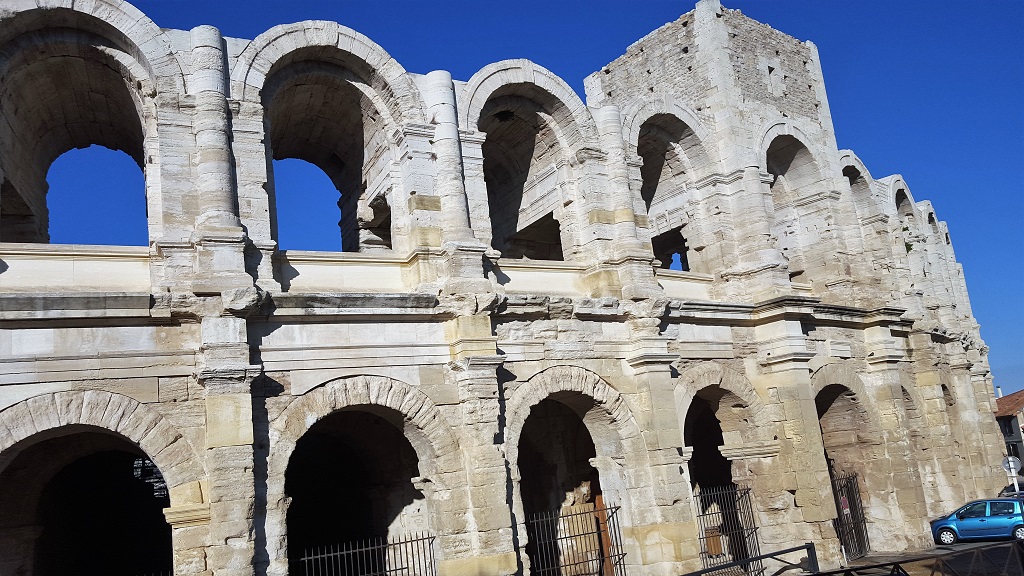
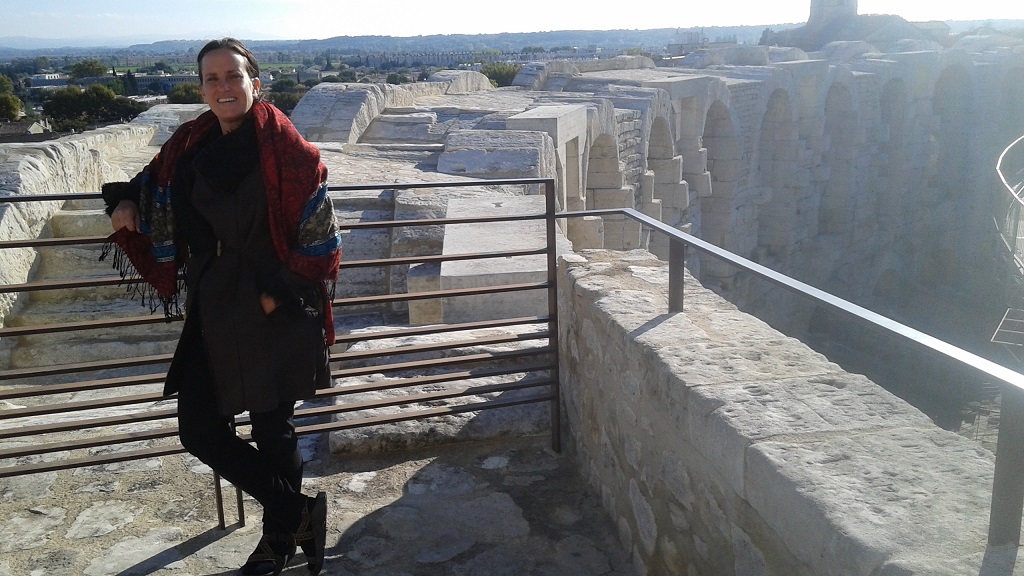
It Is Difficult for American’s to Grok Standing in Buildings That Are 2000 Years Old
Next, we headed to the tourist office to get a map that displays sights related to Vincent Van Gogh. Van Gogh lived in Arles and many of his paintings were inspired by particular sights in the town. He loved the light in Provence, as do many other artists. When I looked for explanations of why the light is special in Provence, I found that the common explanation was that it was related to the mistral. The wind essentially cleans the air as it whips through and when the wind calms down, the particulate matter is gone and the sky is a brilliant shade of blue. It’s the silver lining.
Our first stop was Alychamps, which is a very long and narrow cemetery or necropolis, which has been in existence since the Roman times. It is a quiet corner of the town and it could easily induce contemplation. There were sarcophagi, lining the edges– surely over a thousand of them, sometimes stacked on top of each other. What really had me scratching my head though, is that all the way from medieval times through the 1800’s, many of the sarcophagi had been stolen by farmers to use as troughs for their cattle. Repurposing at its best! At the end of the cemetery was a Romanesque church. Inside of it, Dan brought attention to the melodic sound of the pigeons cooing. It sounded just like monks chanting. Beautiful.
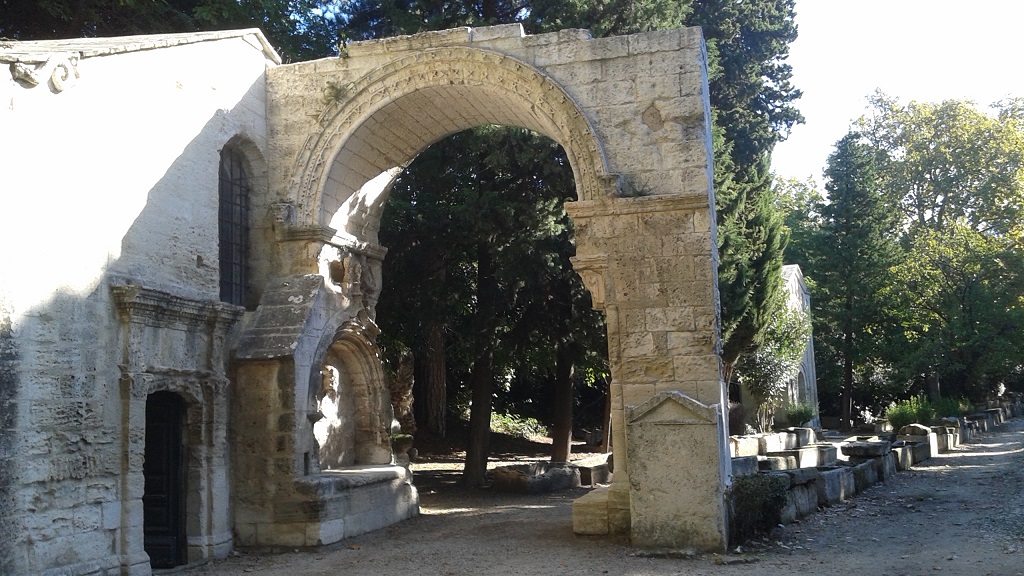
Alychamps (Van Gogh Site)
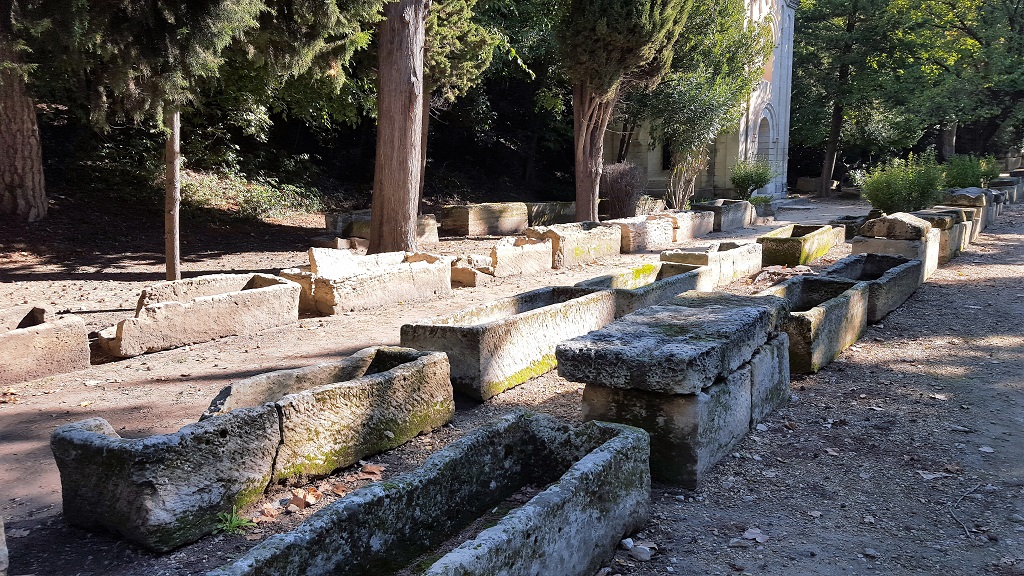
Sarcophagi at Alychamps
We carried on and walked past an old mill (vieux moulin) that inspired Van Gogh, as well as a place where he dwelled in what he refers to in his art as The Yellow House (although now it is open space since it was bombed in 1944). From there we went to where he stood over the Rhone and painted “Starry Night Over the Rhône”, which is not the same as his most famous painting “Starry Night”. I had earlier suggested we watch the sunset from there and how poetic that would be. But honestly, that part of the river was lined with well-worn RV’s with non-properly functioning sewage systems, dogs, and even portable chicken coops. And so, we stood there for a few moments, breathing deeply and imagining how Van Gogh experienced this spot.
Close to where he painted Starry Night over the Rhône, is the bare remains of a bridge. A little bit of it stands on either side, regal, with carved lions. There is a plaque that explains it was bombed in 1944. It was incredible to see how many structures were destroyed, so close to the end of the war. Completely needlessly.
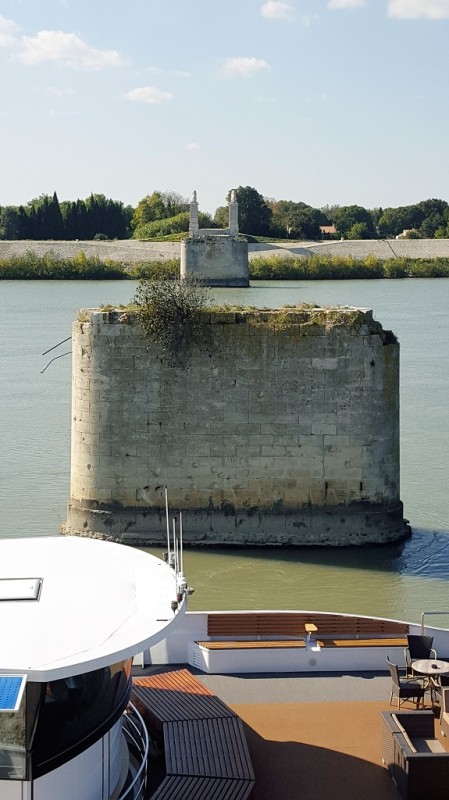
This Bridge Was Destroyed Just Months Before WWII Ended
Speaking of the riverbank. The entire bank through town is on the disheveled side. The buildings are in a state of disrepair and the litter is abundant. I believe someday, Arles will undergo a river revitalization project and this could breathe new energy into the town. I would personally be in favor of such a thing.
From the river side we walked on to the Reattu Museum. Reattu was a local artist, who lived from 1760-1833. The museum was divided into 4 sections, based on art style. To be honest, his work was mediocre and didn’t hold our attention very well. Both Dan and I felt this way, but we both loved the photography exhibit there. Edward Weston and Denis Brihat were two photographers that totally grabbed my attention. Weston has a gift for making fruit and vegetables highly erotic! Now that is a unique talent, as far as I am concerned. I saw photographs taken in California and it was a nice welcome to feel that connection to home (or an approximation of such).
Strolling home, we stopped to buy roasted chestnuts from a street vendor. Childhood memories of NYC rushed back. And next to the chestnut cart, were some street musicians, the man playing a sitar and the woman was making music from a very large saw. This little corner was a delight to be standing on!
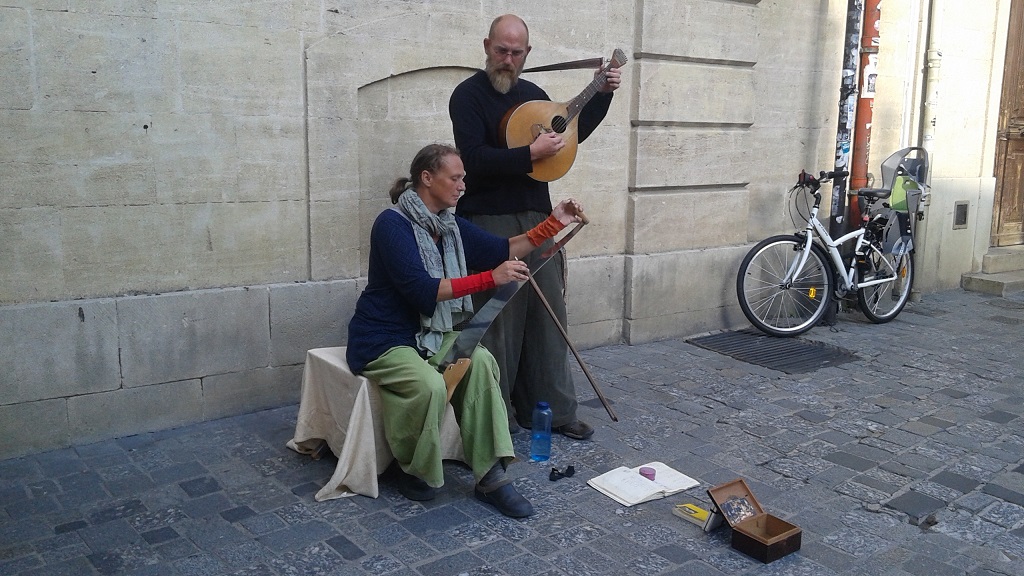
Street Musicians in Old Town
We were planning on heading straight back to the hotel to relax, but the open Antique Théatre with its sunny steps caught our eyes and we wandered in. There were people there touring and just enjoying, but it was in no way crowded. We climbed the steps to what we thought would be a perfect spot in the sun and sprawled out. Talk about heaven! Napping in the sun like a cat (and there were a few cats roaming the area), listening to the birds chirp, and occasionally opening our eyes to take in the ancient Roman scenery was restorative and something you cannot experience in the states. Ever.
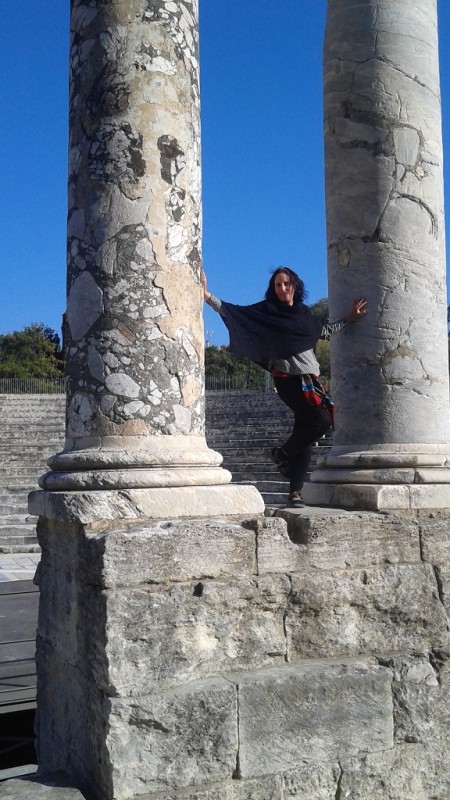
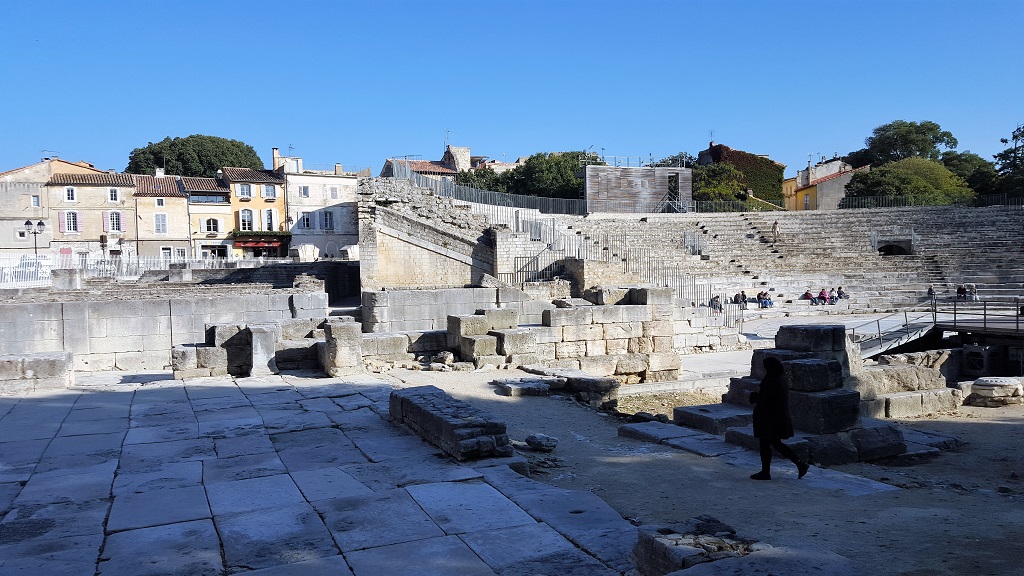
Theatre Antique
I went for a power walk while Dan blogged back at the hotel and when I got back, we got ourselves ready for dinner at Jean-Luc Rabanel’s L’Atelier. We had walked past his mini-empire a few times, as it was just blocks from the hotel. Everywhere we read his name, it was linked with the concept that his food is not to be missed and it is a visual delight. Having eaten at Chassagnette yesterday, we had a pretty high bar in our minds, but once again, we were ready for another culinary adventure.
The service was formal. And like at Chassagnette, we noticed all the staff was under 30 years old. I was wondering if these chefs liked to support youth and give them direction, or if they are cheap labor, or this is simply who applies for these types of jobs. I don’t think I will find out, but in any event, the service was very attentive.
The dining room was perhaps Asian influenced. Intimate, simply decorated. We both liked it. There was no menu, and the waiter gave us a choice of the tasting menu with nine or thirteen dishes. Even though portions were small, we both knew nine dishes would be plenty. We did choose our main plate though.
I am going to not describe every dish we had. Not because the food wasn’t worthy. It was. But I would like to leave it at conveying the feeling of the food and the restaurant.
The first few dishes that came out were wonderful and two of them featured a teardrop shaped dollop of ice cream. It was interesting to have a savory dish (olives, shrimp) with lemon ice cream and a yellow and red beet salad with cheese ice cream. Although actually the flavors mingled very well.
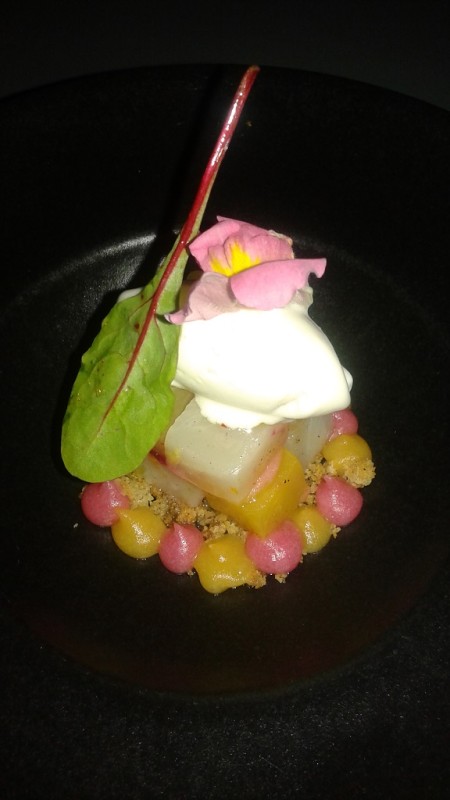
What’s That? Beet Salad!
One of the waitresses came out with a large tray of loaves of bread. It appeared she was just showcasing them and not asking if or what we would like. It was a bit confusing but we went with the show. Now, what came next was even more confusing. The waiter told us to grab our stuff as he was taking us into another room to eat our dinner. Again, we went with the show and didn’t ask questions. We were led into a brightly lit, perhaps modern Provencal decorated room. It was more spacious and as a result, less intimate.
On the table was a basket with many different types of small pieces of bread labeled with their variety. Now it was making sense. Within a handful of minutes, everyone else was brought in as well, so were all on the same serving schedule. The dishes came out, timed well, and with continued excellent service. And each dish, truly was a work of art. Perhaps the prettiest food we had encountered so far on the gastronomic tour. Even the other incredible haute cuisine that we ate at Anne-Sophie or Alain’, was not as pretty as this. And pretty is truly the best word to describe it. The way the colors juxtaposed each other and their layout on the plate — well, suffice it to say, each dish was truly a work of art. In some ways, I hated to destroy the art by consuming it, but it was created exactly for that purpose.
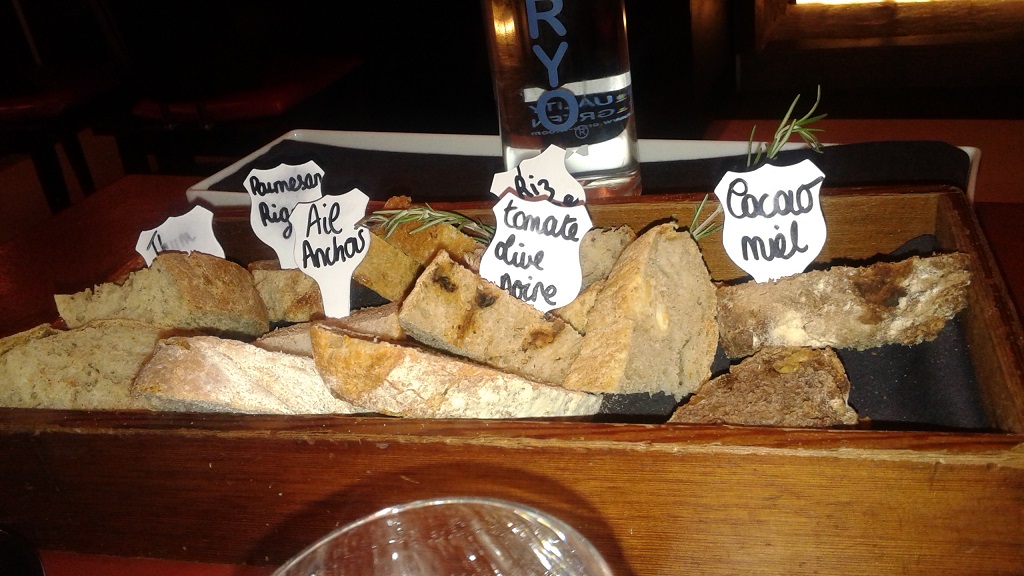
Quite the Selection of Artisan Bread
By the time the main dish of thinly sliced steak with expertly displayed onion and potato came out, we could barely consume any more food. The desserts were stunning in their own right, yet all I could do was nibble. A pineapple gelée with coconut sherbet and small bits of pineapple and mango was very cleansing to the palette. The grapefruit and raspberries arranged beautifully on the plate, gently topped with grapefruit sherbet and custard, and a touch of almond foam, allowed the underappreciated grapefruit (pamplemousse) to strut its stuff.
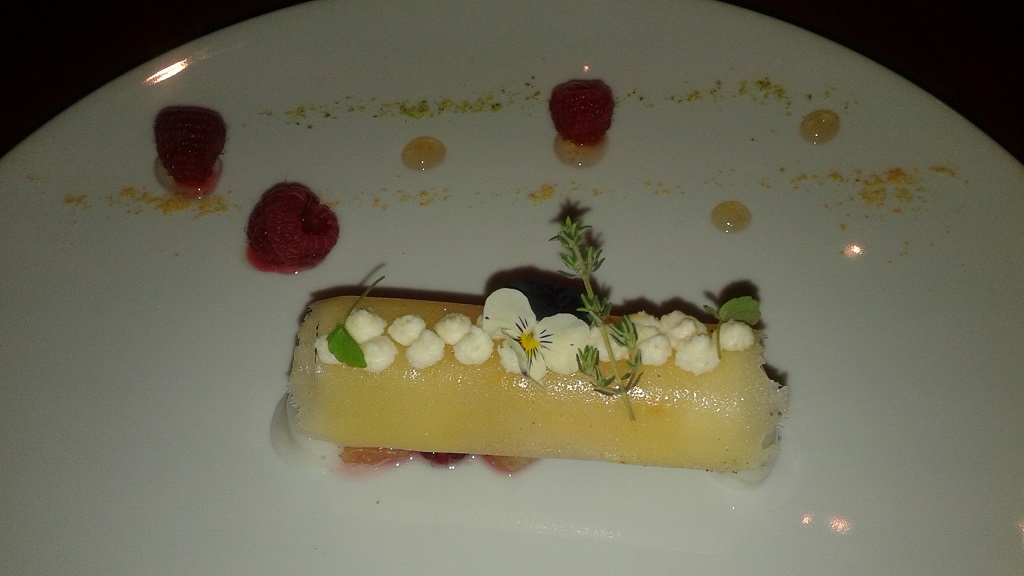
Jean-Luc Creates Edible Masterpieces
A very nice touch that Jean-Luc incorporates into his restaurant is that he comes around and says hello to every patron, which is about eight tables. He is a very interesting looking man, perhaps with a face that is dark and one would see in a scary film. Let’s call him intriguing looking. I had read about this ritual in the reviews in TripAdvisor and was happy to have the opportunity to tell him how much we enjoyed the meal and how beautiful the food was.
Jean-Luc and Armand have different styles and missions (within the common mission of creating incredible food). Both are very purposeful about the atmosphere they want their patrons to experience their creations in, both take great care in sourcing their ingredients (Jean-Luc also grows his own vegetables but not right outside the restaurant which is in an urban area). Both have trained their staff to cater to their guests and to deliver excellent service. Both are actively the chefs in their establishments (lucky us!) and do not rely on surrogates. And most of all, both care deeply about what their food looks and tastes like and they honor the food through bringing it to a high artistic art form.
For more info about Vincent Van Gogh, click here.
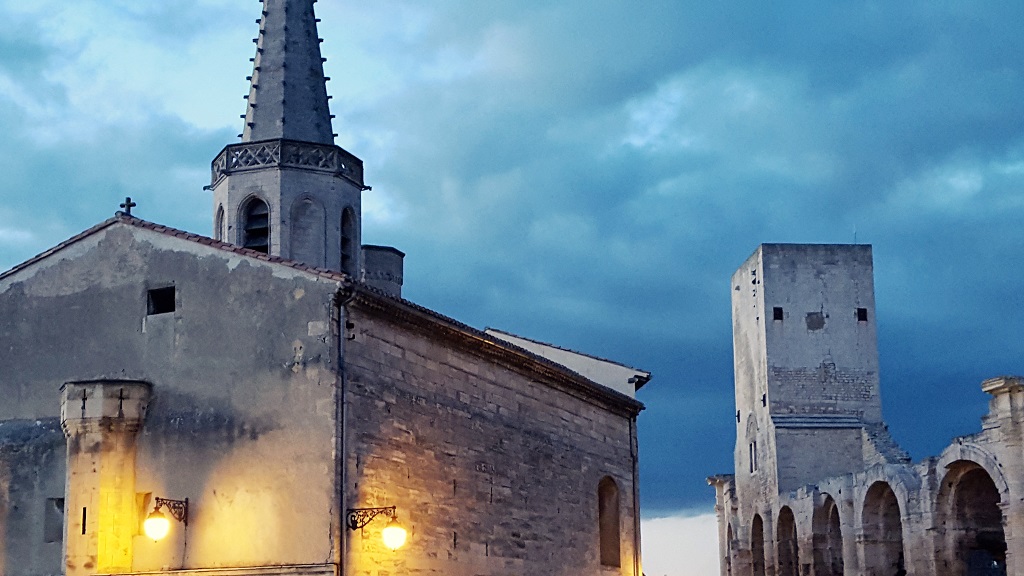
Arles Is Ancient and Mystical
